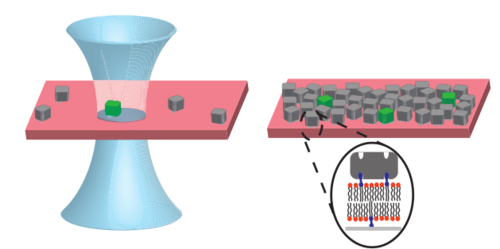Fluorescence correlation spectroscopy (FCS) on crowded membranes
FCS measurement of anomalous transport of avidin proteins attached to a crowded supported lipid bilayer
Experimentally, anomalous transport at the nanoscale can be measured by fluorescence correlation spectroscopy (FCS). Within an experimental collaboration, we have studied the systematic development of anomalous diffusion of proteins attached to a crowded model membrane [10]. Current experimental progress allows the variation of the confocal volume in FCS setups. We have generalised the theoretical framework of the technique and, resorting to simulations, have shown how FCS experiments with spatio-temporal resolution can discriminate different models for anomalous transport [11].
Still, the origin of anomalous transport in cellular membranes is unknown, and the phenomenon has even been observed in protein-free vesicles of phase-separating lipid mixtures. Previous simulation studies relied either on lattice models and artificial dynamics, or on atomistically detailed models lacking sufficiently large system sizes and long observation times. In a future research project, a coarse-grained continuum model shall be developed that generically exhibits fluid–gel coexistence and slow transport. Investigation of this model will yield insight and detailed predictions on the slow dynamics in membranes, which then can stimulate future experiments.
[10] M. R. Horton, F. Höfling, J. O. Rädler, and T. Franosch, Soft Matter 6, 2648 (2010).
[11] F. Höfling, K.-U. Bamberg, and T. Franosch, Soft Matter 7, 1358 (2011).



